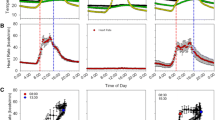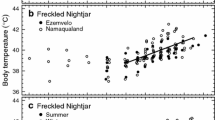Summary
Adelie penguins (Pygoscelis adeliae) experience a wide range of ambient temperatures (T a) in their natural habitat. We examined body temperature (T b), oxygen consumption (\(\dot V_{{\text{O}}_2 } \)), carbon dioxide production (\(\dot V_{{\text{CO}}_2 } \)), evaporative water loss (\(\dot m_{{\text{H}}_2 {\text{O}}} \)), and ventilation atT a from −20 to 30 °C. Body temperature did not change significantly between −20 and 20°C (meanT b=39.3°C).T b increased slightly to 40.1 °C atT a=30°C. Both\(\dot V_{{\text{O}}_2 } \) and\(\dot V_{{\text{CO}}_2 } \) were constant and minimal atT a between −10 and 20°C, with only minor increases at −20 and 30°C. The minimal\(\dot V_{{\text{O}}_2 } \) of adult penguins (mean mass 4.007 kg) was 0.0112 ml/[g·min], equivalent to a metabolic heat production (MHP) of 14.9 Watt. The respiratory exchange ratio was approximately 0.7 at allT a. Values of\(\dot m_{{\text{H}}_2 {\text{O}}} \) were low at lowT a, but increased to 0.21 g/min at 30°C, equivalent to 0.3% of body mass/h. Dry conductance increased 3.5-fold between −20 and 30°C. Evaporative heat loss (EHL) comprised about 5% of MHP at lowT a, rising to 47% of MHP atT a=30°C. The means of ventilation parameters (tidal volume [VT], respiration frequency [f], minute volume [I], and oxygen extraction [\({\text{E}}_{{\text{O}}_{\text{2}} } \)]) were fairly stable between −20 and 10°C (VT did not change significantly over the entireT a range). However, there was considerable inter- and intra-individual variation in ventilation patterns. AtT a=20–30°C,f increased 7-fold over the minimal value of 7.6 breaths/min, and I showed a similar change.\({\text{E}}_{{\text{O}}_{\text{2}} } \) fell from 28–35% at lowT a to 6% atT a=30°C.
Similar content being viewed by others
Abbreviations
- C :
-
thermal conductance
- EHL :
-
evaporative heat loss
- \({\text{E}}_{{\text{O}}_{\text{2}} } \) :
-
oxygen extraction
- f :
-
respiratory frequency
- MHP :
-
metabolic heat production
- \(\dot m_{{\text{H}}_2 {\text{O}}} \) :
-
evaporative water loss
- LCT :
-
lower critical temperature
- RE :
-
respiratory exchange ratio
- T a :
-
ambient temperature
- T b :
-
body temperature
- \(\dot V_{{\text{O}}_2 } \) :
-
rate of oxygen consumption
- \(\dot V_{{\text{CO}}_2 } \) :
-
rate of carbon dioxide production
- I:
-
inspiratory minute volume
- VT:
-
tidal volume
References
Ainley DG, LeResche RE, Sladen WJL (1983) Breeding biology of the Adelie penguin. University of California Press, Berkeley
Aschoff J, Pohl H (1970) Der Ruheumsatz von Vögeln als Funktion der Tageszeit und der Körpergröße. J Ornithol 111:38–47
Bech C, Johansen K (1980) Ventilatory and circulatory responses to hyperthermia in the mute swan (Cygnus olor). J Exp Biol 88:195–204
Bech C, Rautenberg W, May B (1985) Ventilatory oxygen extraction during cold exposure in the pigeon (Columba livia). J Exp Biol 116:499–502
Bernstein MH, Samaniego FC (1981) Ventilation and acid-base status during thermal panting in pigeons (Columba livia). Physiol Zool 54:308–315
Brent R, Pedersen PF, Bech C, Johansen K (1984) Lung ventilation and temperature regulation in the European coot (Fulica atra). Physiol Zool 57:19–25
Bucher TL (1981) Oxygen consumption, ventilation and respiratory heat loss in a parrot,Bolborhynchus lineola, in relation to ambient temperature. J Comp Physiol 142:479–488
Bucher TL (1985) Ventilation and oxygen consumption inAmazona viridigenalis: a reappraisal of ‘resting’ respiratory parameters in birds. J Comp Physiol B 155:269–276
Calder WA, King JR (1974) Thermal and caloric relations in birds. In: Farner DS, King JR (eds) Avian biology, vol 4. Academic Press, New York, pp 259–413
Calder WA, Schmidt-Nielsen K (1968) Panting and carbon dioxide in birds. Am J Physiol 215:447–482
Chappell MA, Bucher TL (1987) Effects of temperature and altitude on ventilation and gas exchange in chukars (Alectoris chukar). J Comp Physiol B 157:129–136
Drent RH, Stonehouse B (1971) Thermoregulatory response of the Peruvian penguin,Spheniscus humboldti. Comp Biochem Physiol 40A:689–710
Gessaman JA (1972) Bioenergetics of the snowy owl (Nyctea scandiaca). Arctic Alpine Res 4:223–238
Hammel HT, Maggert J, Kaul R, Simon E, Simon-Opperman CH (1976) Effects of altering spinal cord temperature on temperature regulation in the Adelie penguin,Pygoscelis adeliae. Pflügers Arch 362:1–6
Johansen K, Bech C (1983) Heat conservation during cold exposure in birds (vasomotor and respiratory implications). Polar Res 1 n.s.: 259–268
Kaiser T, Bucher TL (1985) The consequences of reverse sexual size dimorphism for oxygen consumption, ventilation and water loss in relation to ambient temperature in the Prairie Falcon,Falco mexicanus. Physiol Zool 58:748–758
Kooyman GL, Gentry RL, Bergman WP, Hammel HT (1976) Heat loss in penguins during immersion and compression. Comp Biochem Physiol 54:75–80
Lasiewski RC (1972) Respiratory function in birds. In: Farner DS, King JR (eds) Avian biology, vol 2. Academic Press, New York, pp 287–342
Le Maho Y, Delclitte P, Chatonnet J (1976) Thermoregulation in fasting Emperor Penguins under natural conditions. Am J Physiol 231:913–922
Malan A (1973) Ventilation measured by body plethysmography in hibernating mammals and in poikilotherms. Respir Physiol 17:32–44
Murrish DE (1973) Respiratory heat and water exchange in penguins. Respir Physiol 19:262–270
Murrish DE (1982) Acid-base balance in three species of Antarctic penguins exposed to thermal stress. Physiol Zool 55:137–143
Pinshow B, Fedak MA, Battles DR, Schmidt-Nielsen K (1976) Energy expenditure for thermoregulation and locomotion in emperor penguins. Am J Physiol 231:903–912
Ramirez JM, Bernstein MH (1976) Compound ventilation during thermal panting in pigeons: a possible mechanism for minimizing hypocapnia alkalosis. Fed Proc 35:2562–2565
Simon E, Simon-Opperman CH, Hammel HT, Kaul R, Maggert J (1976) Effects of altering rostral brain stem temperature on temperature regulation in the Adelie penguin,Pygoscelis adeliae. Pflügers Arch 362:7–13
Sokal RF, Rohlf FJ (1981) Biometry (2nd edn). Freeman, San Francisco
Taylor JRE (1985) Ontogeny of thermoregulation and energy metabolism in pygoscelid penguin chicks. J Comp Physiol B 155:615–628
Tracy CR, Welch WR, Porter WP (1980) Properties of air: a manual for use in biophysical ecology (3rd edn). Technical Report No. 1, Laboratory for Biophysical Ecology, University of Wisconsin, Madison, Wisconsin
Author information
Authors and Affiliations
Rights and permissions
About this article
Cite this article
Chappell, M.A., Souza, S.L. Thermoregulation, gas exchange, and ventilation in Adelie penguins (Pygoscelis adeliae). J Comp Physiol B 157, 783–790 (1988). https://doi.org/10.1007/BF00691009
Accepted:
Issue Date:
DOI: https://doi.org/10.1007/BF00691009




